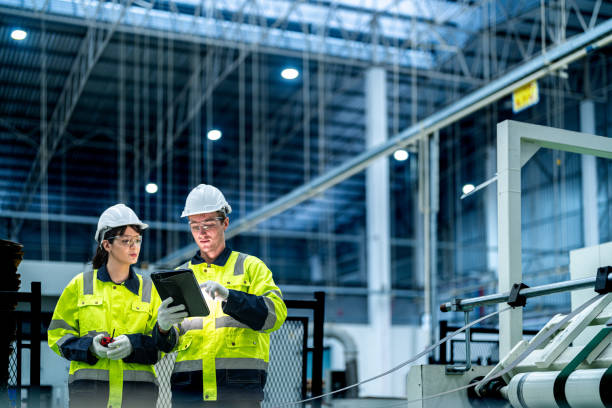Modular Factories: Revolutionizing Industrial Flexibility
Manufacturing agility meets architectural innovation in the realm of modular factories, a groundbreaking approach reshaping industrial landscapes worldwide. This concept marries the efficiency of prefabrication with the adaptability demanded by rapidly evolving markets, offering a solution to the age-old challenge of balancing productivity with versatility. As industries grapple with unpredictable demand and the need for swift operational pivots, modular factories emerge as a beacon of operational ingenuity, promising to redefine the very foundations of industrial infrastructure.

The concept draws inspiration from diverse fields, including the modular building techniques used in commercial construction and the lean manufacturing principles popularized in the automotive industry. Early adopters of modular factory design were often found in industries requiring rapid deployment, such as disaster relief or military operations. However, the potential for broader industrial application quickly became apparent as businesses sought ways to adapt swiftly to market changes and technological advancements.
Anatomy of a Modular Factory
At its core, a modular factory consists of prefabricated units or modules that house specific production processes or functions. These modules are designed to be self-contained, often including all necessary utilities, equipment, and control systems. The modular approach extends beyond mere physical structure, encompassing the entire factory ecosystem:
-
Production Modules: These are the heart of the modular factory, housing specific manufacturing processes. They can range from assembly lines to clean rooms for sensitive operations.
-
Utility Modules: Dedicated units for power distribution, HVAC systems, and other utilities ensure each production module can function independently.
-
Logistics Modules: Specialized units for material handling, storage, and inventory management facilitate smooth operations across the factory.
-
Office and Administrative Modules: These provide necessary workspace for management and support staff, seamlessly integrated into the factory layout.
-
Connector Systems: Standardized interfaces allow for quick connections between modules, enabling rapid reconfiguration of the factory layout.
The Strategic Advantage of Modularity
Modular factories offer a host of strategic benefits that address many of the challenges faced by traditional manufacturing facilities:
-
Scalability: As demand fluctuates, modules can be added or removed to adjust production capacity without significant disruption to ongoing operations.
-
Flexibility: The ability to reconfigure the factory layout allows for swift adaptation to new product lines or manufacturing processes.
-
Speed to Market: Reduced construction and setup times mean new production facilities can be operational in a fraction of the time required for traditional factories.
-
Cost Efficiency: Standardization and prefabrication lead to lower construction costs and reduced downtime during expansions or reconfigurations.
-
Sustainability: Modular designs often incorporate energy-efficient technologies and can be easily upgraded to meet evolving environmental standards.
Implementing Modular Factory Design
Transitioning to a modular factory model requires careful planning and a shift in design philosophy. Key considerations include:
-
Standardization: Developing a set of standardized module designs that can be mixed and matched to create various factory configurations.
-
Interface Design: Creating robust, standardized connections between modules for utilities, data, and material flow.
-
Process Optimization: Rethinking manufacturing processes to fit within modular constraints while maximizing efficiency.
-
Supply Chain Integration: Adapting supply chain strategies to support the dynamic nature of modular production environments.
-
Workforce Training: Preparing the workforce to operate in a more flexible and reconfigurable manufacturing environment.
Challenges and Future Outlook
While modular factories offer significant advantages, they also present unique challenges. Initial investment costs can be higher than traditional construction, and the standardization required may limit certain specialized manufacturing processes. Additionally, regulatory frameworks may need to evolve to accommodate these novel industrial structures.
Looking ahead, the concept of modular factories is poised for growth. Advancements in prefabrication technologies, coupled with the increasing need for manufacturing agility, will likely drive wider adoption. Future developments may include:
-
Integration of advanced robotics and automation systems designed specifically for modular environments.
-
Development of “smart” modules with built-in AI and IoT capabilities for self-optimization.
-
Creation of module marketplaces, allowing companies to lease or exchange production modules as needed.
-
Emergence of specialized modular factory designers and integrators, offering turnkey solutions for businesses.
Key Insights for Industrial Innovators
• Conduct a modular feasibility study to identify which parts of your manufacturing process are best suited for modularization.
• Invest in standardized interface designs to ensure seamless integration between modules and future-proof your factory layout.
• Develop a modular master plan that outlines potential factory configurations to meet various production scenarios.
• Create a digital twin of your modular factory to simulate reconfigurations and optimize layouts before physical implementation.
• Establish partnerships with modular manufacturing specialists to stay abreast of the latest developments in this rapidly evolving field.
As industries continue to navigate an era of unprecedented change, modular factories stand as a testament to the power of innovative thinking in industrial design. By embracing this flexible, scalable approach to manufacturing infrastructure, businesses can position themselves to thrive in an increasingly dynamic global marketplace. The modular factory concept not only promises enhanced operational agility but also opens new avenues for sustainable growth and competitive advantage in the industrial sector.





